Hong Kong could be at 'tipping point' as warning flag unfurled at Chinese military barracks

Hong Kong (CNN)The Chinese military garrison in Hong Kong offered a rare public reaction in the face of taunts from protesters Sunday, as violence escalated across the city over the weekend.
Video from Hong Kong public broadcaster RTHK shows a yellow flag raised from atop a People's Liberation Army (PLA) building in Kowloon Tong, in north Kowloon, warning protesters they could be prosecuted if they continued to approach the barracks. The flag appears to be similar to those used by police during protests.
Half a dozen personnel could be seen standing on top of the barracks shining flashlights at dozens of protesters below, who were aiming laser pointers and other lights at the building. The incident is believed to be the first known interaction between people inside the PLA barracks and protesters during 18 weeks of anti-government demonstrations.
Hong Kong police said they could not confirm or deny the incident. The PLA could not be reached for comment.
It comes as protests intensified over the weekend following Hong Kong Chief Executive Carrie Lam's use of emergency powers to ban face masks at public gatherings.
The city's MTR subway network suspended all of its operations after demonstrators vandalized multiple train stations, setting fire to entrances and smashing ticketing facilities. Numerous mainland Chinese-owned banks and stores were also targeted by protesters.
Violent protests began Friday in opposition to the ban and stretched across the city throughout the weekend, with protesters throwing petrol bombs and police responding with pepper spray and tear gas. On Friday, a lone plain clothed police officer shot a 14-year-old boy in the leg after being attacked by protesters -- the second time deadly force was used against protesters after an officer shot a protester during clashes on October 1.
Speaking Friday, Yang Guang, spokesman for the Hong Kong and Macao Affairs Office of China's State Council, the country's top law-making body, said the current unrest "cannot be endless."
"More effective measures to stop the violence and ease the unrest" must be used, Yang said, adding the central government supports the anti-mask law.

A China Construction Bank (Asia) is vandalized in Causeway Bay district on October 6, 2019 in Hong Kong, China.
'A tipping point'
Use of colonial era emergency powers to institute the anti-mask law marks a significant escalation in the Hong Kong government's handling of the now four-month long protests.
The emergency powers -- which give the city's Chief Executive effective carte blanche to make new laws as necessary in the instance of a severe breakdown of public order -- have not been tested in court since Hong Kong's return to China in 1997 and could be found unconstitutional under the city's Basic Law, the de facto constitution, which guarantees rights such as public assembly and free expression.
Experts say the government's move to invoke emergency powers as well as the protesters' targeting of Chinese-owned business could move Hong Kong further toward a possible Chinese intervention.
"The very fact that the violence is intensifying in Hong Kong, both from the police against the protesters and the protesters are responding back in kind, I think, suggests that we are sort of reaching a tipping point in this," said Malcolm Davis, senior analyst in Defense Strategy and Capability at the Australian Strategic Policy Institute. "They (Beijing) can't let this go on indefinitely. They can't let it continue to intensify."
The Chinese military has had a presence in Hong Kong since the city was handed over from British to Chinese control in 1997. It is estimated that PLA garrison houses around 6,000 soldiers.
Under the city's constitution, the Hong Kong government can request the assistance of the garrison "in the maintenance of public order and in disaster relief."
Police and government officials have repeatedly denied any need to call on the military, even as the protests have taken an increasingly violent turn.
This has not stopped the rampant concern that at some point Beijing could crack down in Hong Kong.
In mid-August, China deployed large numbers of paramilitary personnel close to the border in Shenzhen. CNN teams on the ground saw uniformed members of the People's Armed Police Force (PAP) with riot shields and batons, as well as numerous semi-militarized vehicles, stationed at the city's Bay Sports Center.
A few weeks later China sent in fresh military troops to the Hong Kong garrison, saying it was part of the annual rotation of its personnel in and out of the territory.

A protester throws a tear gas canister back toward police in Hong Kong on Sunday, October 6.

A masked protestor holding a shield stops for a portrait in Hong Kong on October 6.

Protesters vandalize the Cheung Sha Wan local government offices in Hong Kong on October 6.
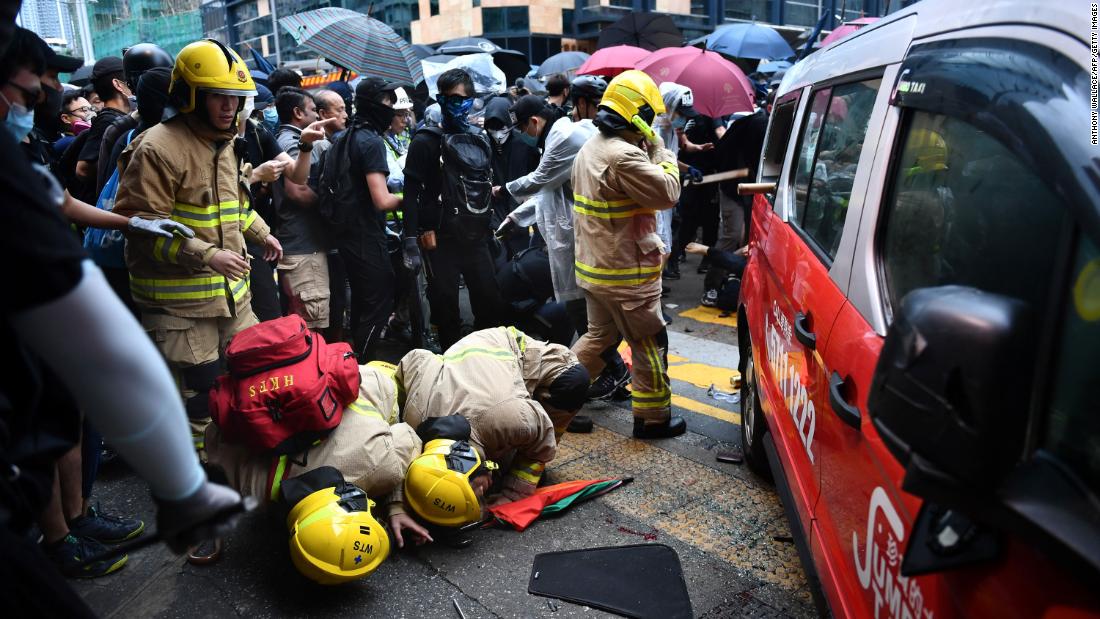
Rescue personnel check the bottom of a taxi after the driver allegedly drove onto the pavement, hitting protesters in Hong Kong on October 6.

A China Construction Bank is seen vandalized in the Causeway Bay area of Hong Kong on October 6.

Pro-democracy protesters set fires in the street in the Causeway Bay area of Hong Kong on October 6.
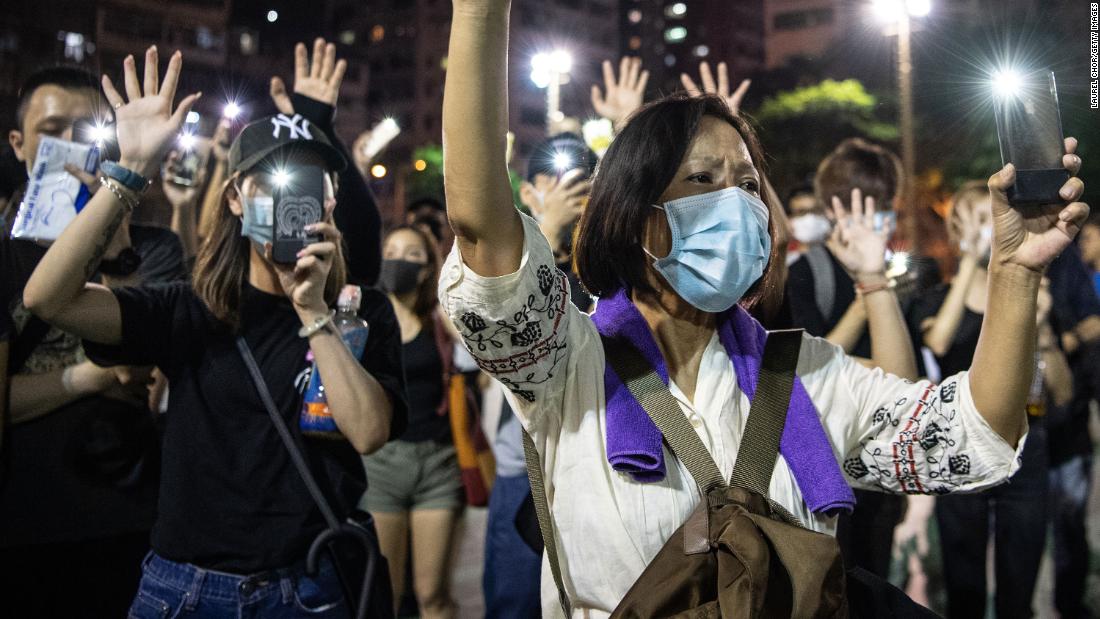
People protest a ban against masks on Saturday, October 5, in Hong Kong.

Hong Kong police detain a protester on October 5 on the streets.

An anti-government protester stands near a fire on Friday, October 4.

Protesters move a statue depicting a protester armed with gas mask, helmet and umbrella on the streets of Hong Kong on October 4.

Protesters set a fire on October 4 at China Construction Bank.

Riot police deploy tear gas on October 4 outside a restaurant during a protest in the Causeway Bay district of Hong Kong.

Protesters spray paint slogans on October 4 at the entrance to a tunnel.

A fire is seen on October 4 in front of a store vandalized by protesters.

A store is seen on October 4 after being vandalized by protesters.
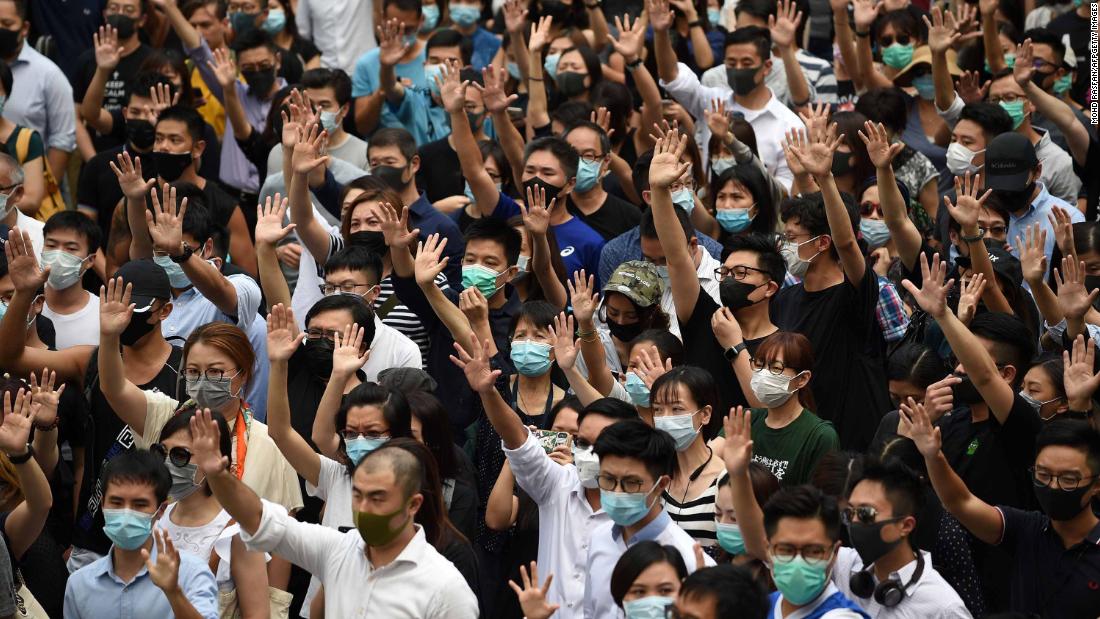
Pro-democracy demonstrators hold up their hands on October 4 to symbolize their five demands during a rally against a government ban on protesters wearing face masks in Hong Kong.

Protesters throw petrol bombs at the gate to the Tsuen Wan police station on Wednesday, October 2, in response to the police's use of live ammunition during clashes with demonstrators in the Tsuen Wan district the previous day.

Schoolmates of a student who was shot in the chest by police during violent pro-democracy protests on October 1 place their hands on their chests during a protest in Hong Kong on Wednesday.
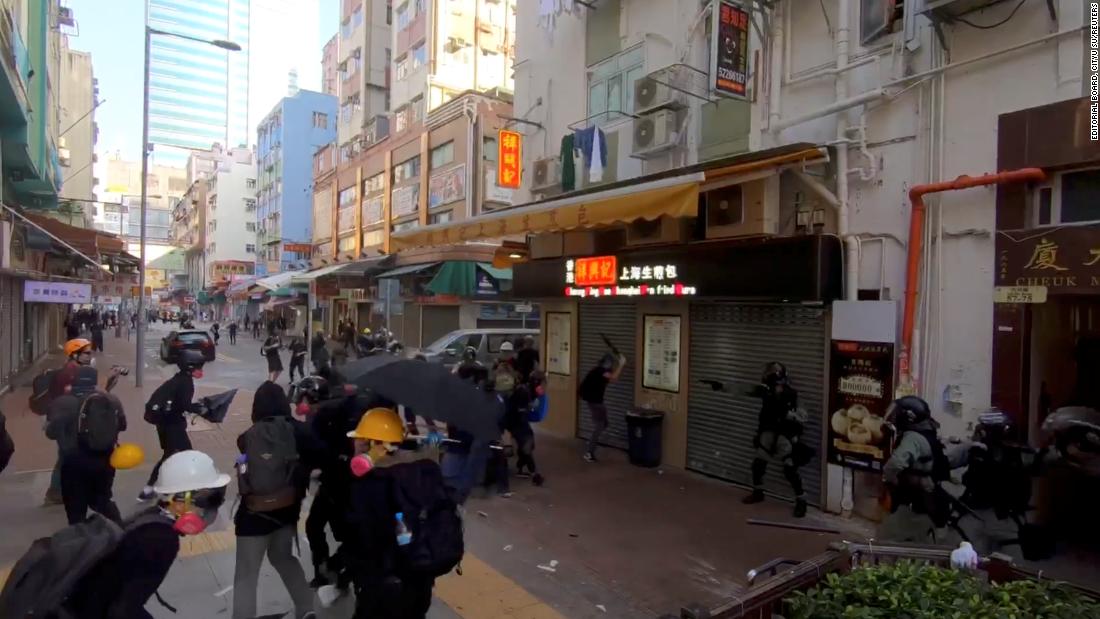
A young protester was shot Tuesday, October 1, as violent protests erupted across Hong Kong on the 70th anniversary of the People's Republic of China. The incident marked a major escalation in violence that could galvanize the protest movement in Hong Kong.

Police detain an anti-government protester in Hong Kong, October 1. Thousands of black-clad protesters marched in central Hong Kong as part of multiple pro-democracy rallies Tuesday as the party celebrated its 70th year of rule.

Black-clad protestors stand surrounded by smoke from tear gas shells on October 1.

Marching anti-government protesters are seen through a window with peeled off posters on October 1.

Police tackle and arrest pro-democracy protesters during clashes in Wan Chai on October 1.
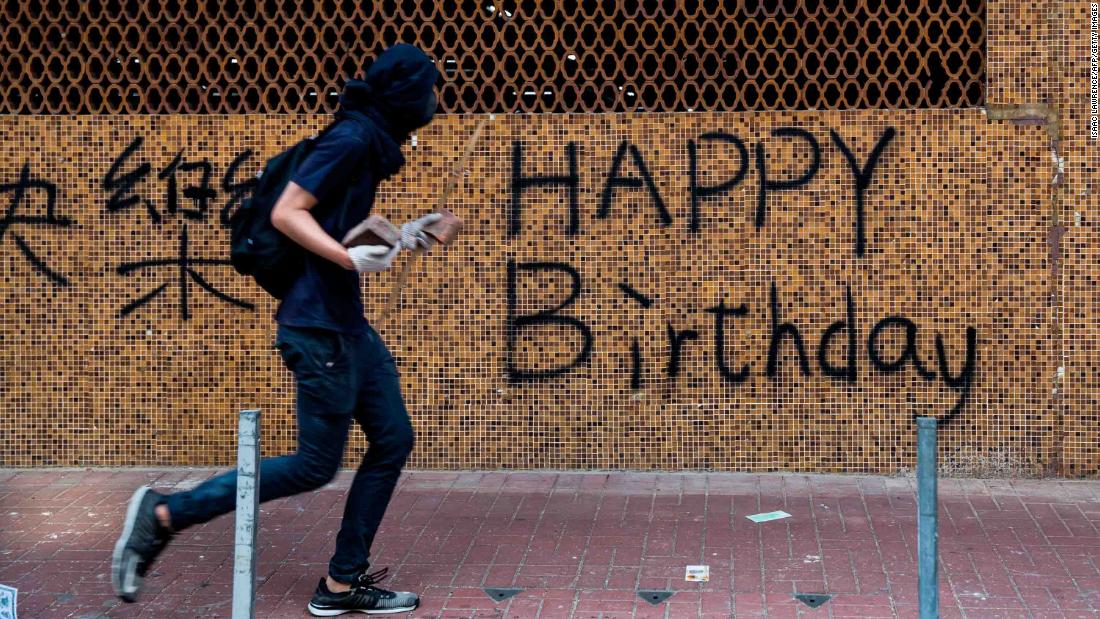
A protester is seen carrying rocks on a street in the Sha Tin district of Hong Kong on October 1. While events in Beijing were being held to mark the 70th anniversary of the founding of the People's Republic of China, demonstrators rallied throughout Hong Kong as the pro-democracy movement enters its fourth month.

Protesters react after police fired tear gas near the central government offices in the Admiralty area of Hong Kong on October 1.
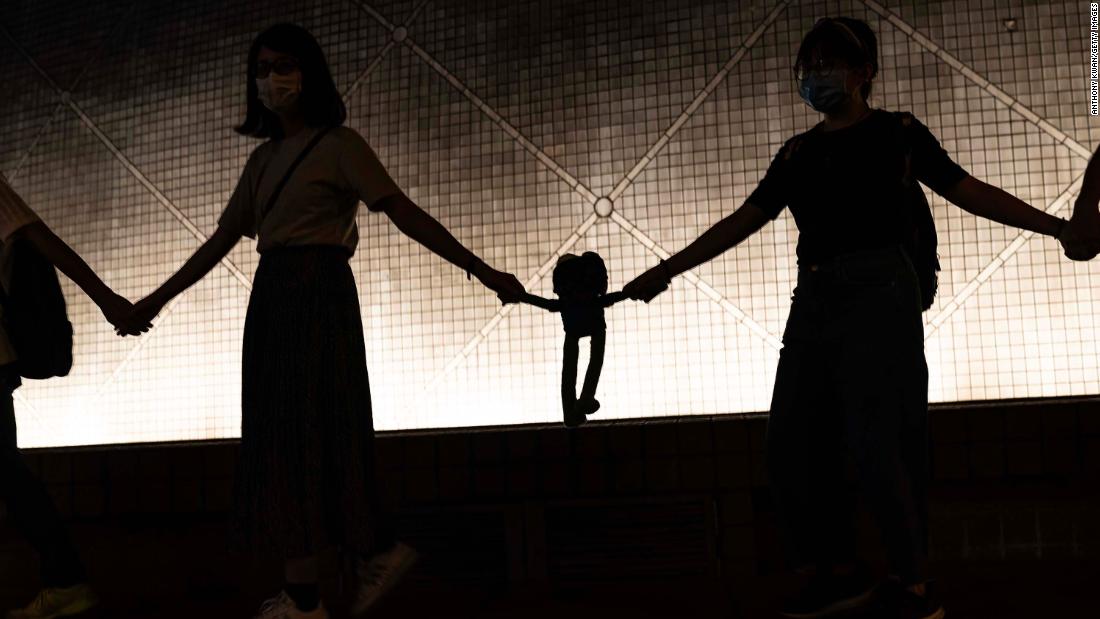
Pro-democracy protesters form a "Pepe the Frog" themed human chain in Hong Kong on Monday, September 30.

A man is detained by Hong Kong police during a protest in the Causeway Bay shopping district on Sunday, September 29.

Riot police arrive after protestors vandalize in Hong Kong on September 29.

Passengers look out from a bus at a burning barricade lit by pro-democracy protesters during a gathering in front of Mong Kok police station on Sunday, September 22, in Hong Kong, China. Pro-democracy protesters have continued demonstrations across Hong Kong, calling for the city's Chief Executive Carrie Lam to immediately meet the rest of their demands, including an independent inquiry into police brutality, the retraction of the word riot to describe the rallies, and genuine universal suffrage, as the territory faces a leadership crisis.

Pro-democracy protesters sing songs and chant slogans during a rally inside a shopping mall in Shatin on September 22.

An anti-government protester throws a Molotov cocktail during a demonstration near Central Government Complex in Hong Kong on Sunday, September 15.

A pro-China supporter, center, is escorted by police after confronting journalists in Hong Kong, on September 15.

Pro-government and anti-government supporters chant against one another at a shopping mall in Hong Kong on Friday, September 13. The sign translates to "Stop violence and curb chaos; safeguard Hong Kong."

Demonstrators hold up their cell phone lights as they form a human chain at the Peak, a tourist spot in Hong Kong, on September 13.
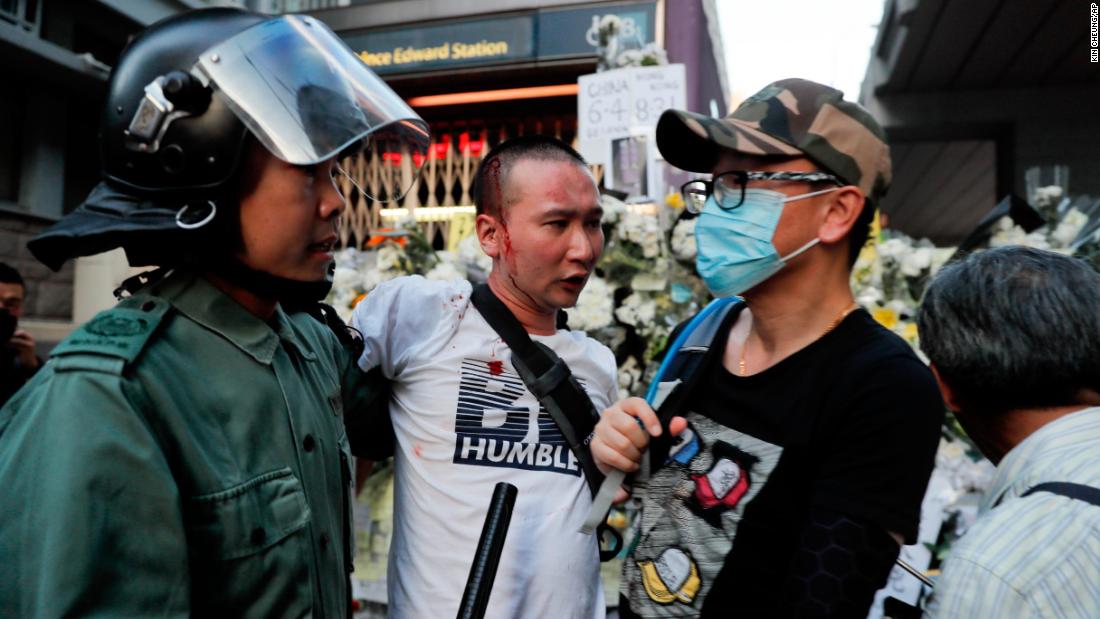
Police escort an injured man after he attacked protesters outside Prince Edward station in Hong Kong on Friday, September 6.
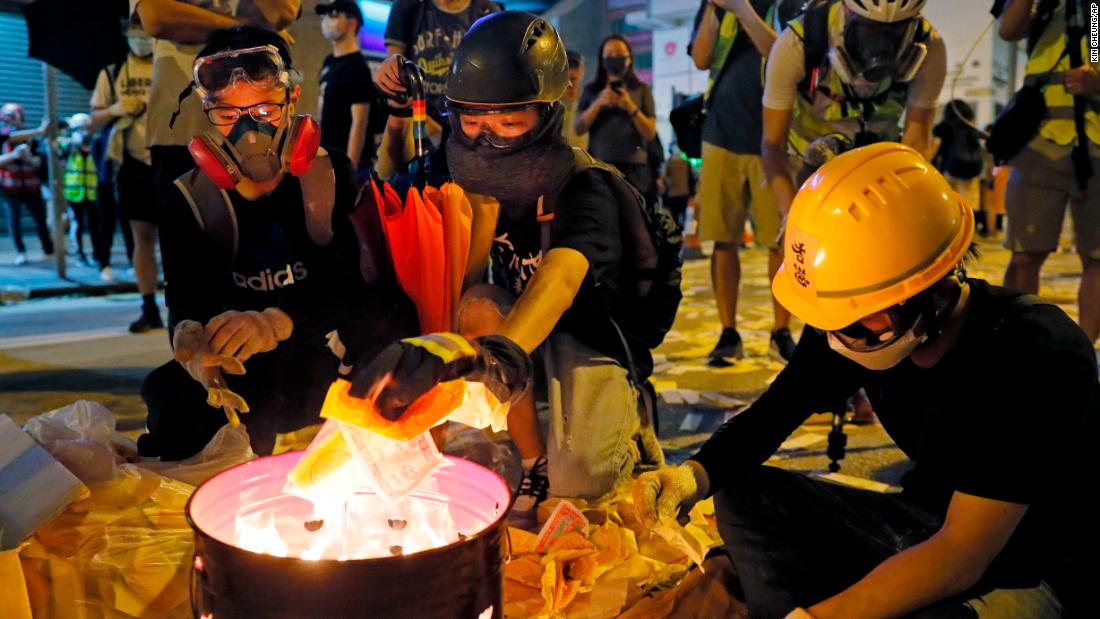
Protesters burn paper money to pay their respects to injured protesters.
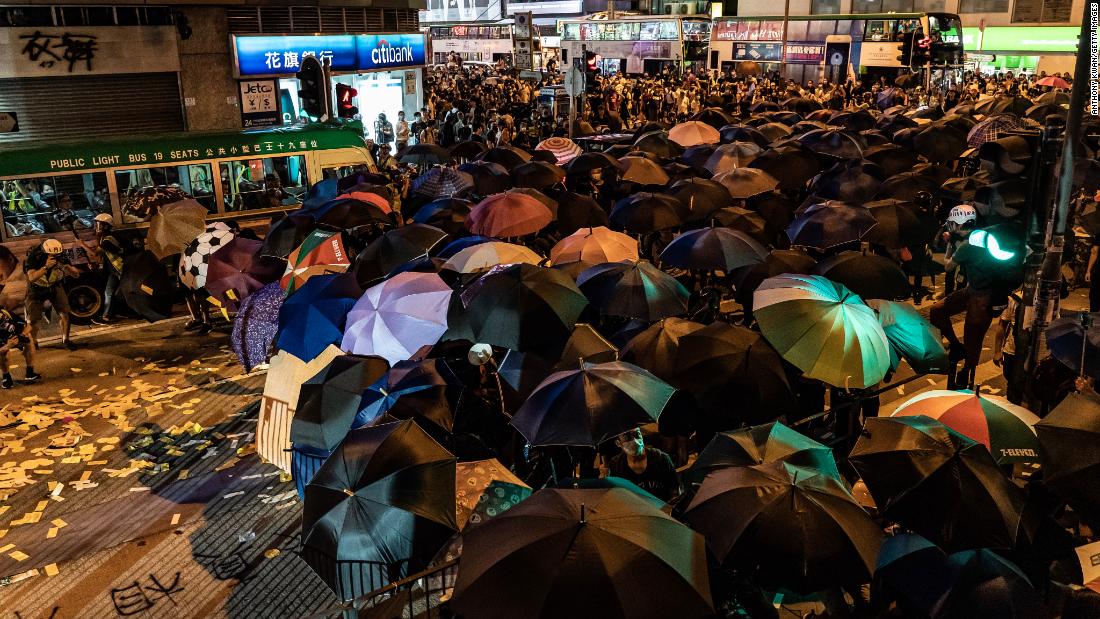
Protesters prepare to clash with police outside the Mong Kok police station on September 6.

A protester is detained by police at the Po Lam Mass Transit Railway station on Thursday, September 5.

A man watches televisions at a store in Hong Kong as Chief Executive Carrie Lam announces the withdrawal of the extradition bill on Wednesday, September 4.
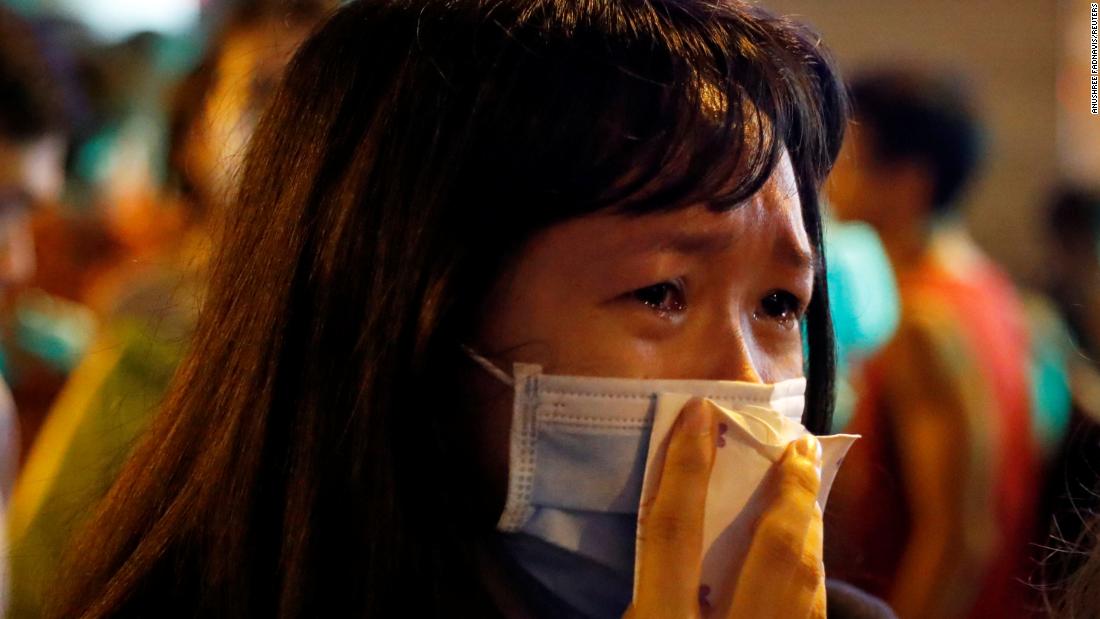
A woman gets emotional on September 4 while paying her respects to protesters who were injured a few days earlier.

Demonstrators travel through a railway station during a rally on Tuesday, September 3.

Students wearing gas masks and helmets hold a banner that reads "five major demands are indispensable" at St. Francis' Canossian College in Hong Kong.

Protesters gather in the bus terminal at Hong Kong International Airport on Sunday, September 1. Hundreds of pro-democracy activists attempted to block transport routes to the city's airport.

A passenger walks to the airport on September 1 as pro-democracy protesters blocked a road outside the airport.

A protester uses a slingshot outside the Central Government Complex during clashes with police on Saturday, August 31. Thousands of pro-democracy protesters held an anti-government rally one day after several leading activists and lawmakers were arrested in a sweeping crackdown.
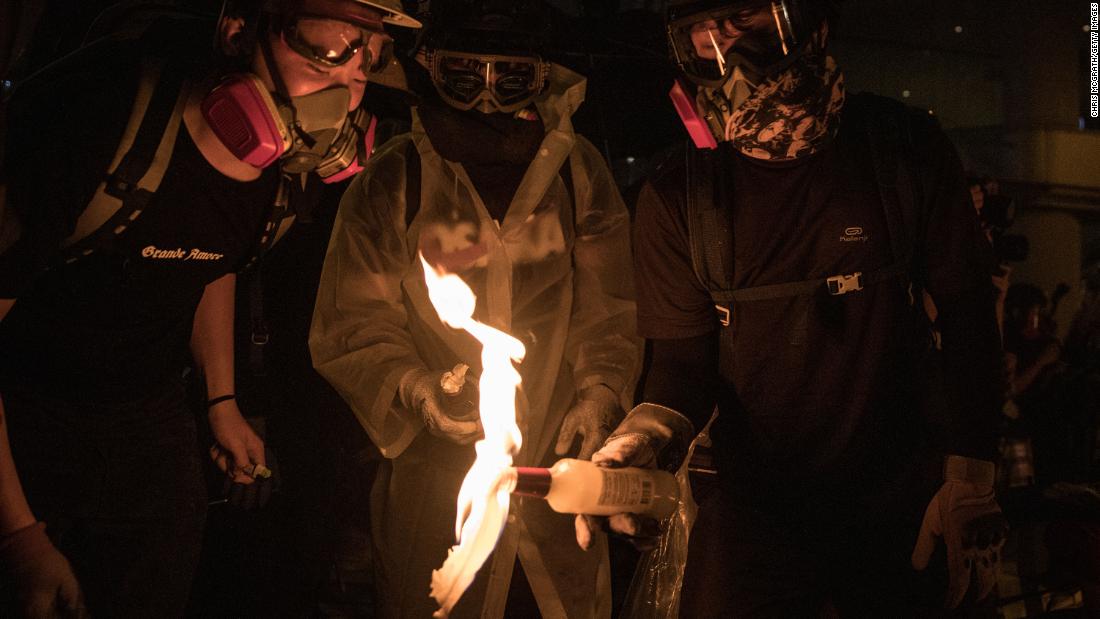
Protesters light a Molotov cocktail on August 31.

Police officers move forward during clashes with protesters on August 31.
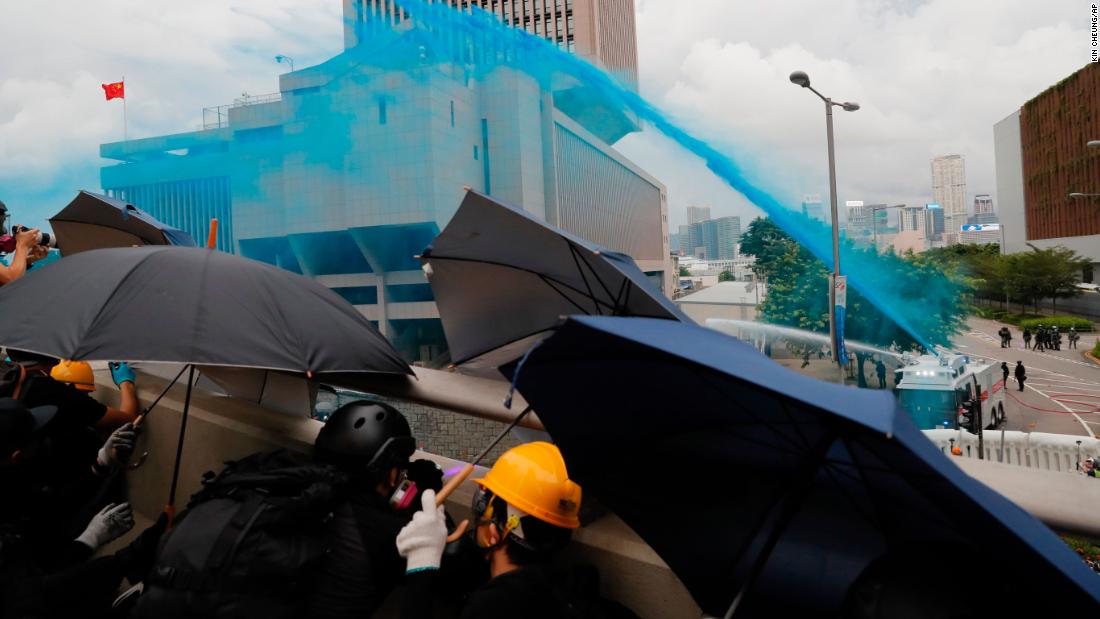
Protesters take cover as policemen fire blue-colored water on them. Blue dye can be used to stain and identify masked protesters.
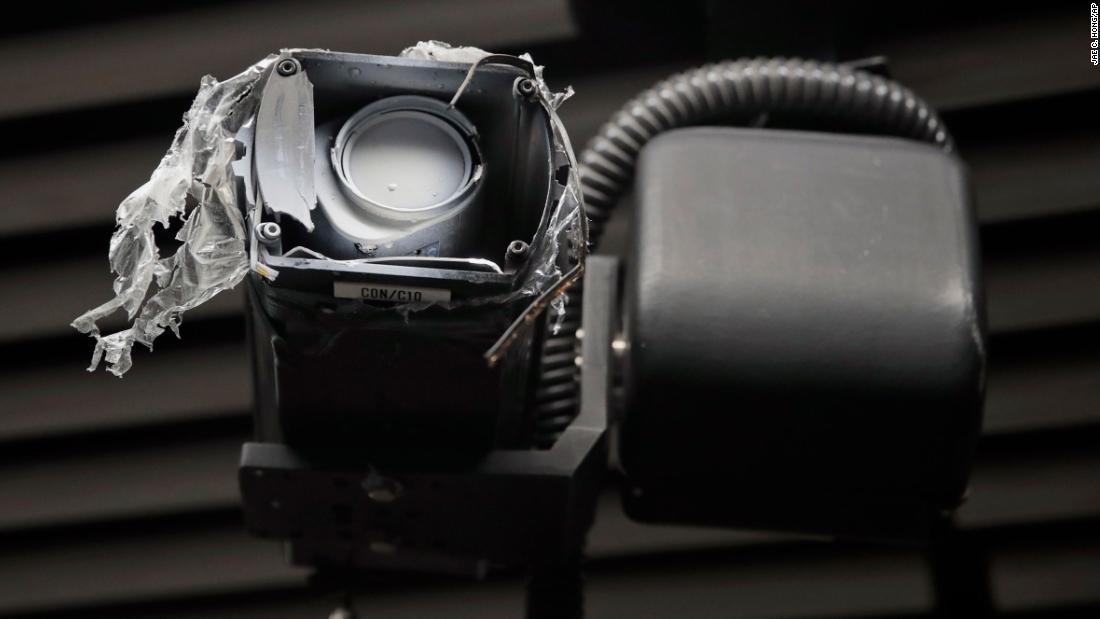
A surveillance camera is covered with white paint during protests.

An overhead view shows protesters reacting after police fired tear gas on August 31.

Pro-democracy activists Agnes Chow and Joshua Wong speak to the media after they were released on bail at the Eastern Magistrates Courts on Friday, August 30. They were arrested earlier the same day in a dragnet across Hong Kong.

Protesters clash with police after a rally in Hong Kong's Tsuen Wan district on Sunday, August 25. It was one of the most violent nights seen in Hong Kong since mass protests began in June.
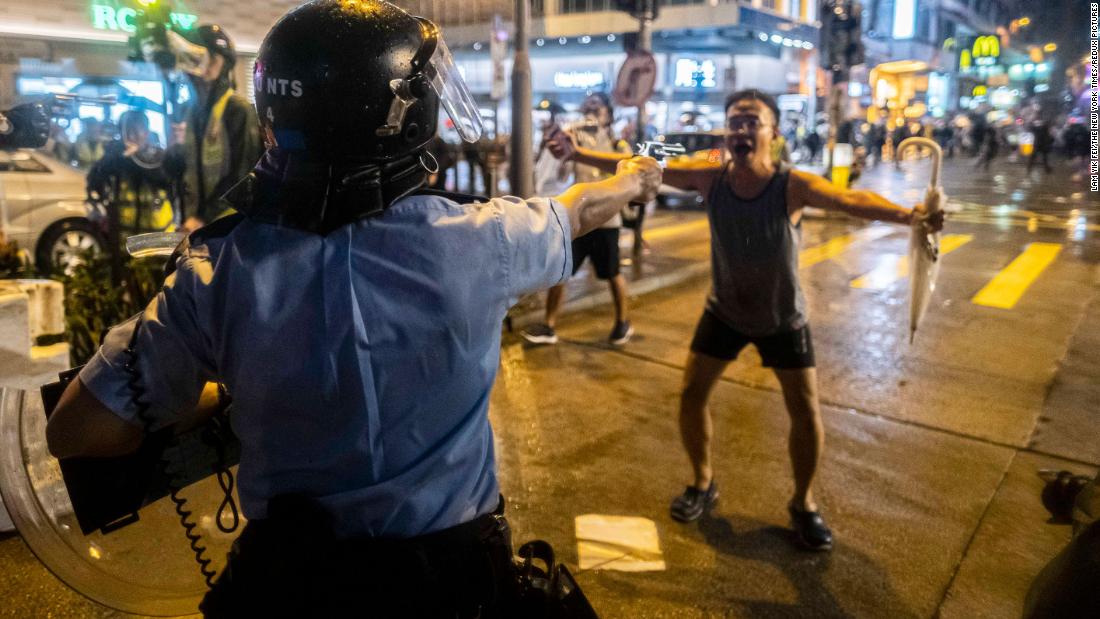
A police officer aims a gun in front of a protester on August 25.

Some protesters shine laser pointers at police lines on August 25.

Protesters and police clash on Saturday, August 24.
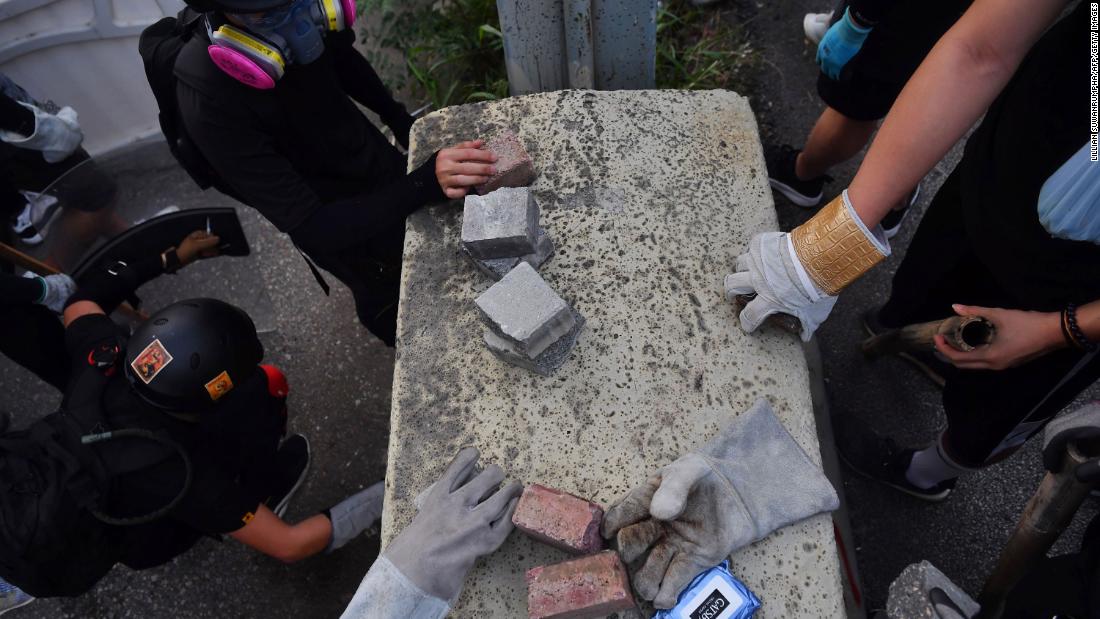
Protesters pick up bricks to be used as projectiles on August 24.
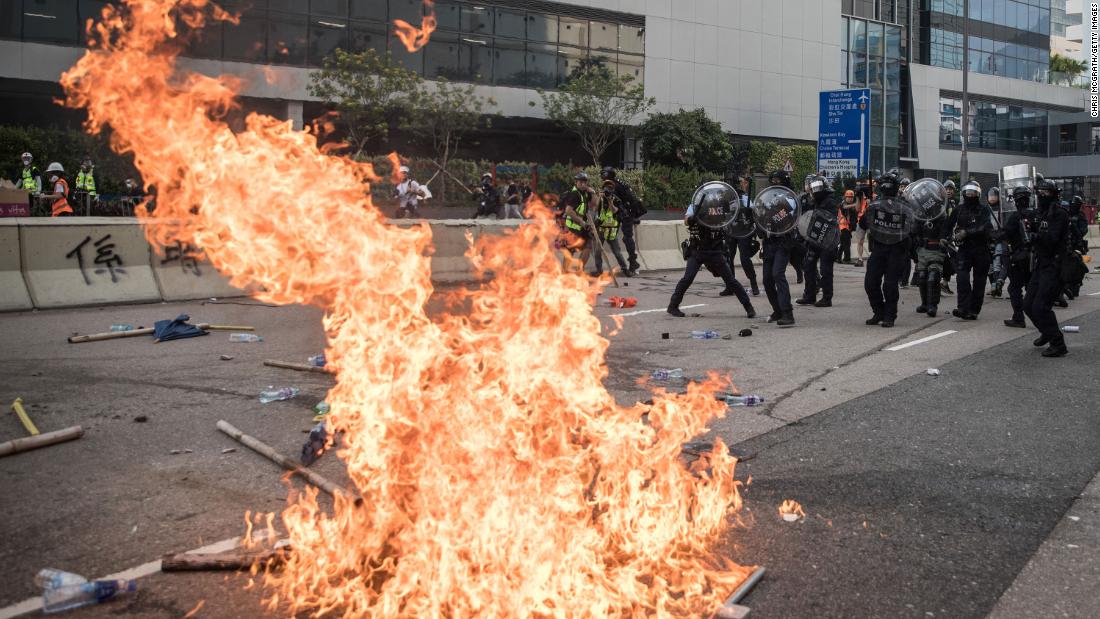
Police retreat after clashing with protesters on August 24.

People link hands as they gather at the Tsim Sha Tsui waterfront on Friday, August 23. Protesters formed a human chain across Hong Kong in a show of solidarity.

Cell phones shine from the top of Lion Rock on August 23.

Protesters march under umbrellas on Sunday, August 18.
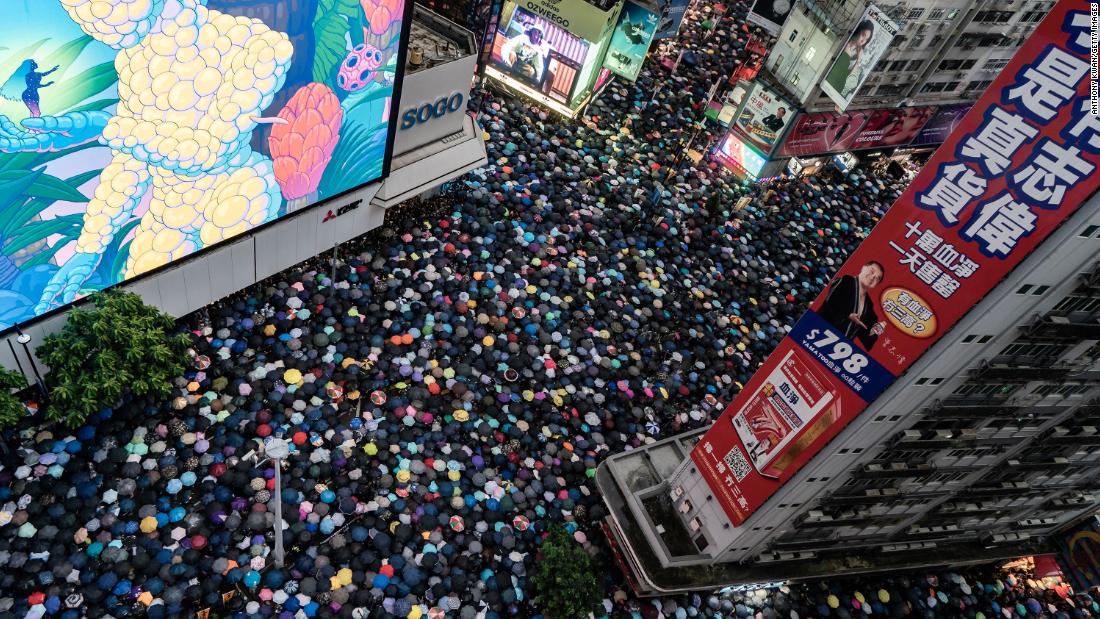
Tens of thousands of protesters showed up in the streets on August 18.
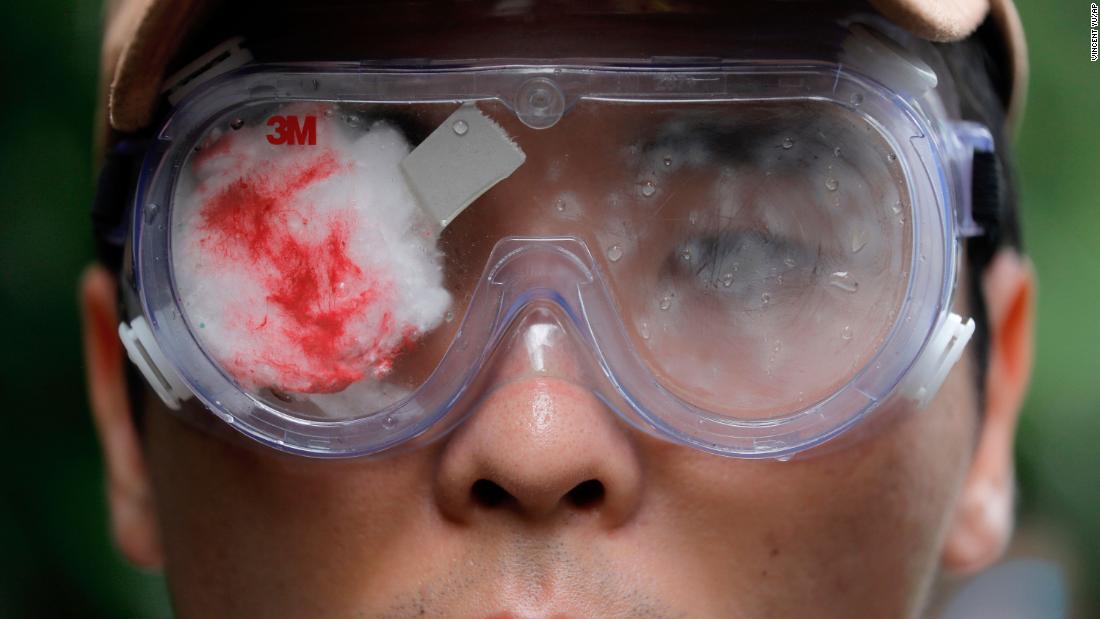
A protester participates in a march on Saturday, August 17. His eye is covered with red gauze, referencing a woman who was allegedly shot in the eye with a beanbag round during clashes between protesters and police.

Protesters react after police fired tear gas to disperse a demonstration at the Sham Shui Po police station in Hong Kong on Wednesday, August 14.

Protesters point lasers at the Sham Shui Po police station on August 14.
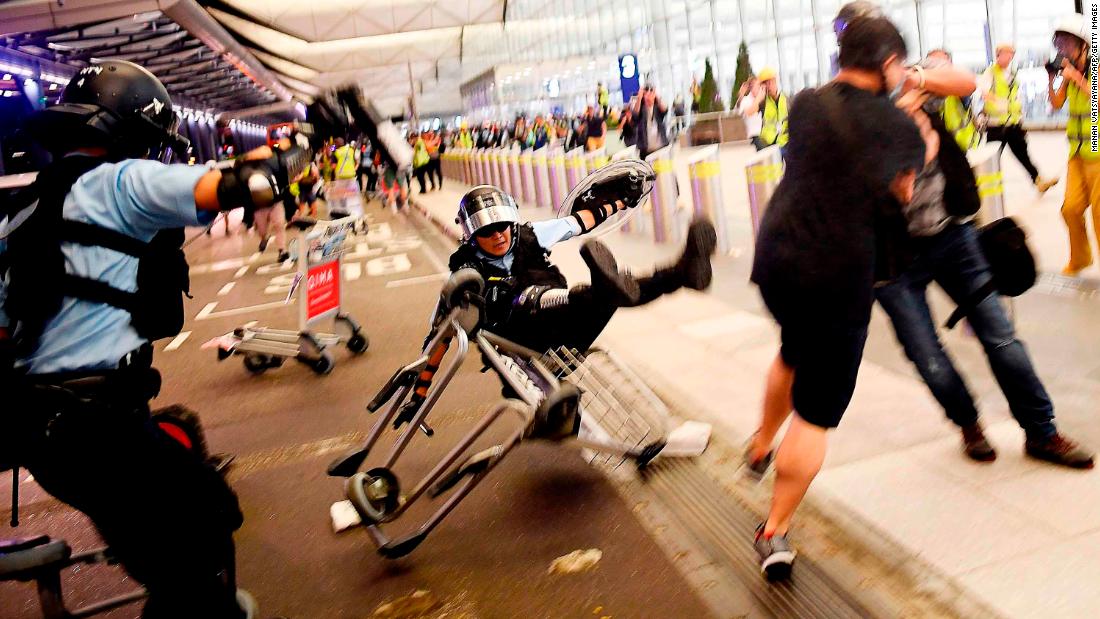
A police officer falls over an airport luggage trolley during a scuffle with pro-democracy protesters on Tuesday, August 13. For two days, protesters flooded the airport. Check-ins were suspended and dozens of outgoing flights were canceled.

Police use pepper spray to disperse protesters at the airport on August 13.

Police and protesters clash at the airport on August 13. The violence came after Hong Kong's Airport Authority announced that all check-in services would be suspended for another night because of terminal operations being "seriously disrupted."

A traveler passes her luggage to security guards as she tries to enter the departures gate.
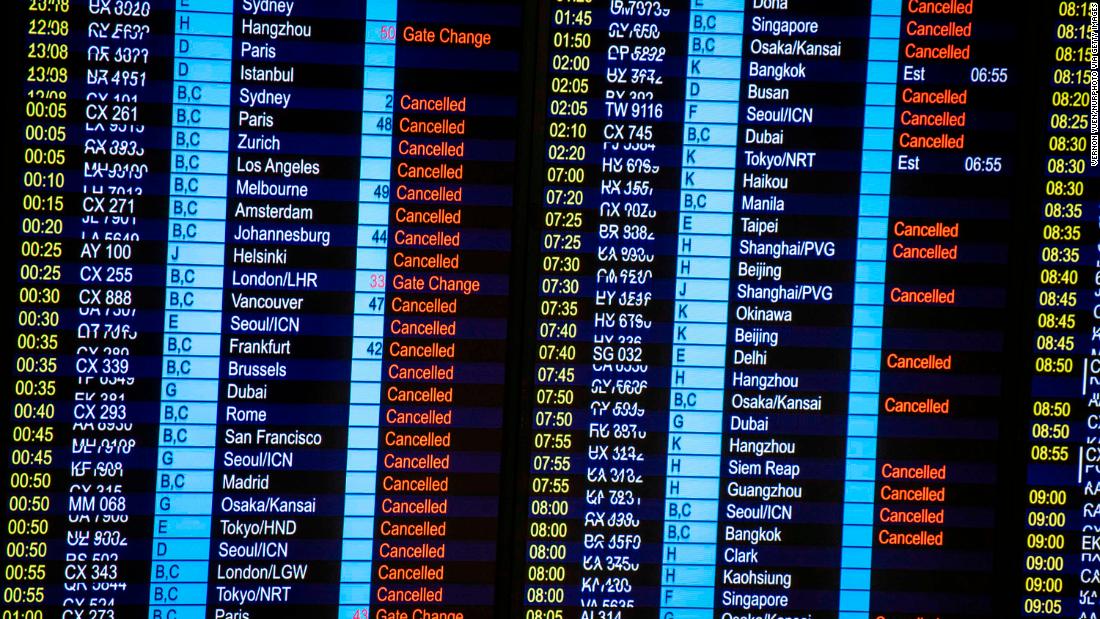
A display board shows canceled flights on August 13.

Anti-government protesters stand at a barricade made of luggage trolleys during a demonstration at the airport on August 13.

Medics look after a woman who received a facial injury during clashes on Sunday, August 11.
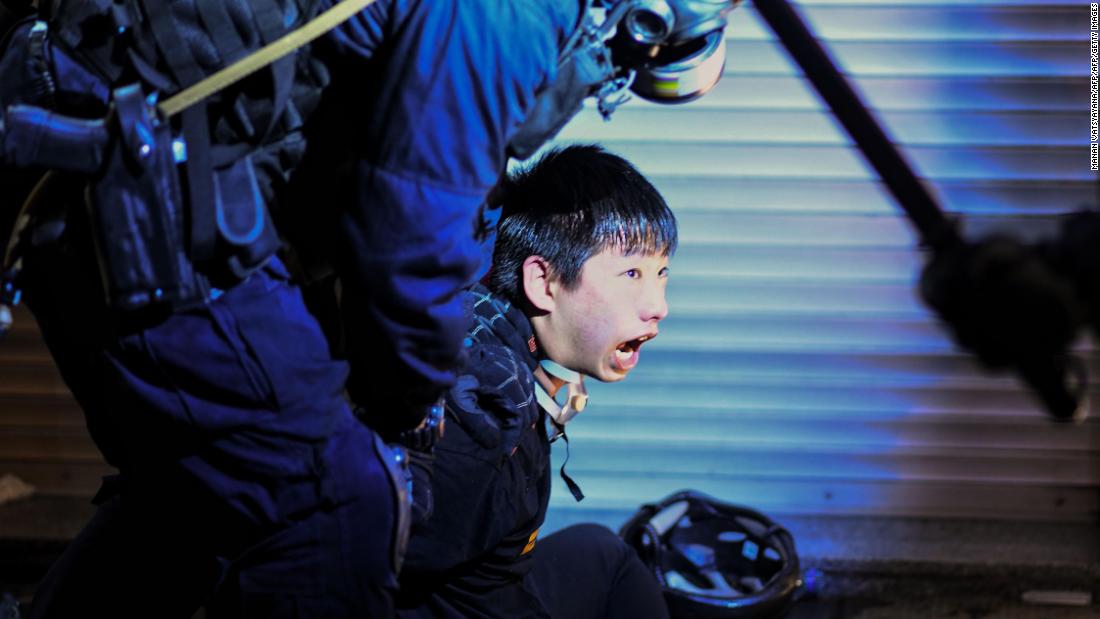
A pro-democracy protester is held by police outside the Tsim Sha Tsui police station on August 11.

Police fire tear gas at protesters during a demonstration in the Wong Tai Sin District on Monday, August 5.

A train passenger gestures toward a protester, right, who was preventing the doors of a train from closing on August 5. The protester was trying to disrupt Hong Kong's morning rush-hour commute.

A man lies down on an underground train during a protest on August 5.
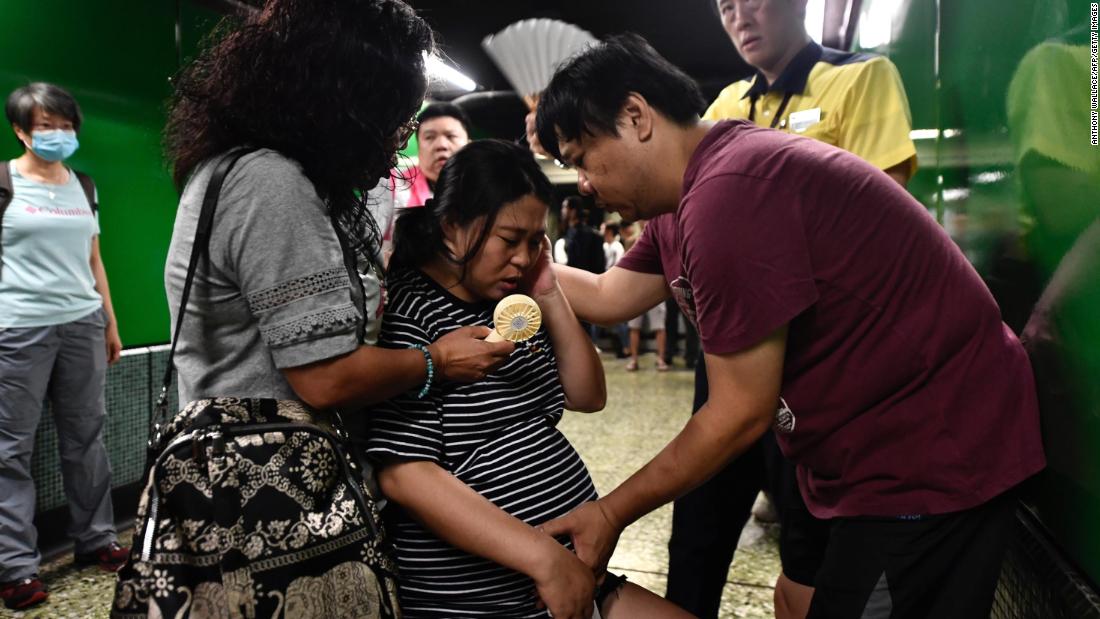
A man comforts his pregnant wife near a train platform after protesters blocked the train doors on August 5.

A protester stands in tear gas during a confrontation with police in the early hours of Sunday, August 4.

A Chinese flag floats in water after it was thrown by protesters during a demonstration on Saturday, August 3.

A protester sprays paint on a wall on August 3.
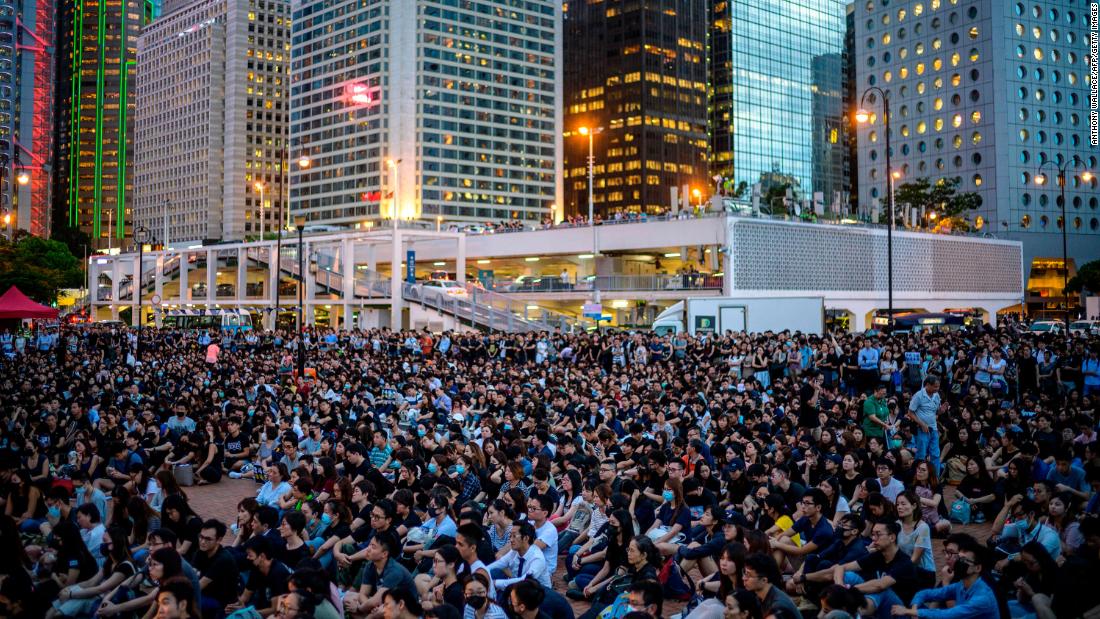
Members of Hong Kong's medical sector attend a protest in Edinburgh Place on Friday, August 2.

The emblem on the China Liaison Office is protected by plexiglass during a demonstration on Sunday, July 28.

A protester flees from baton-wielding police in the Yuen Long district of Hong Kong on Saturday, July 27.

A protester looks through umbrellas during the clashes with police on July 27.

Travelers watch as protesters rally at Hong Kong's international airport on Friday, July 26.

Protesters clash with police on Sunday, July 21.

Masked men in white T-shirts are seen after attacking anti-extradition bill demonstrators at a train station in Yuen Long.
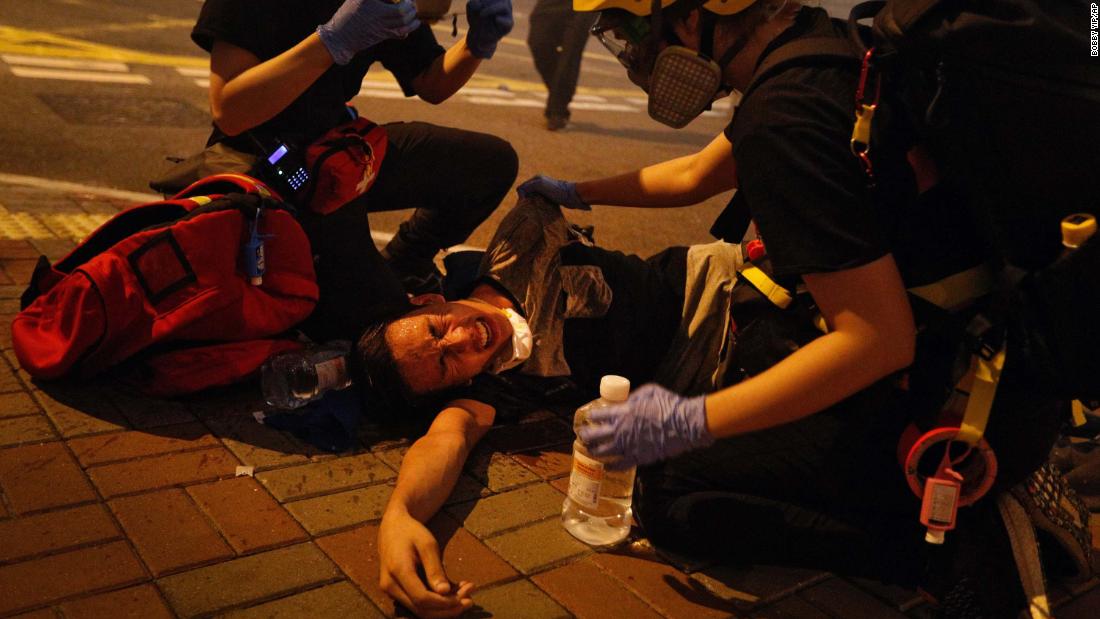
Medical workers help a protester affected by tear gas on July 21.
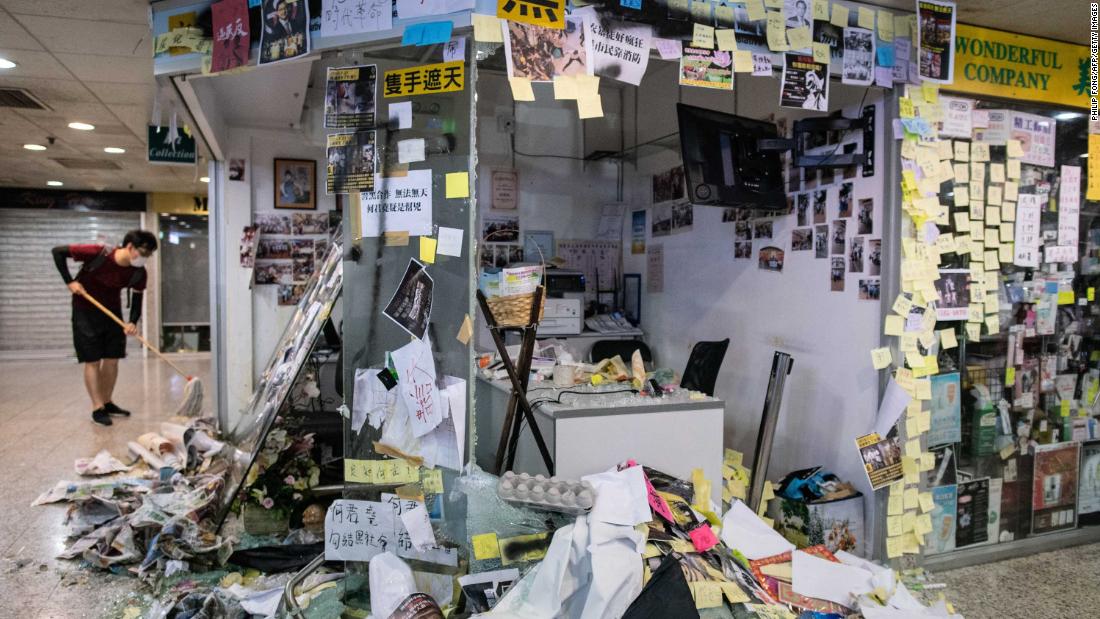
The office of pro-Beijing lawmaker Junius Ho was trashed by protesters in Hong Kong's Tsuen Wan district.

Police officers use pepper spray to disperse protesters after a rally in the Sheung Shui district on Saturday, July 13.
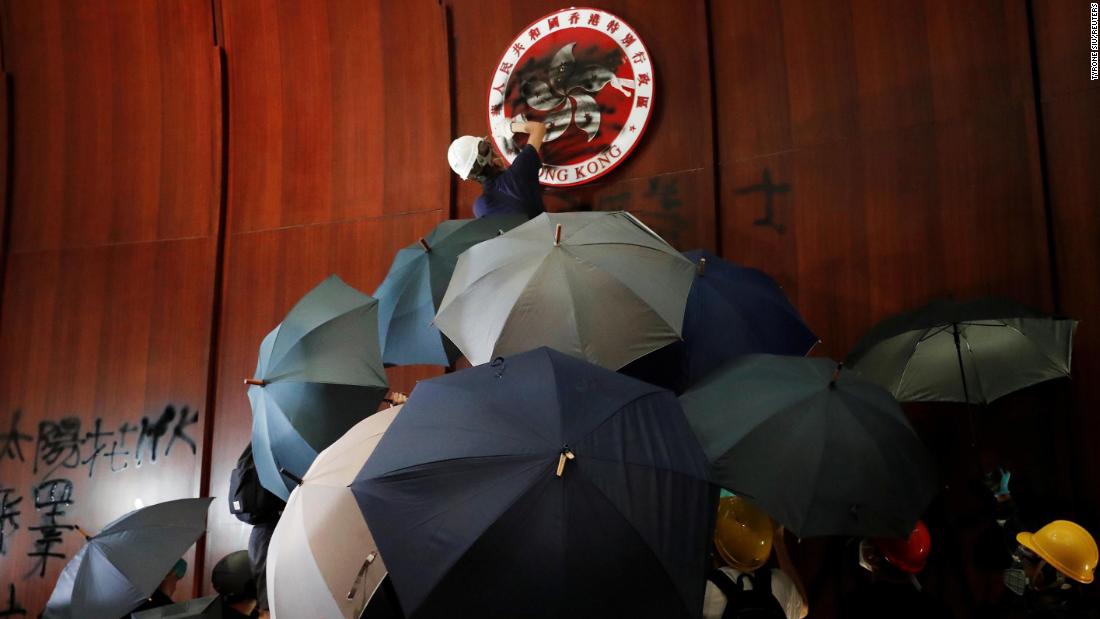
A demonstrator sprays paint inside a chamber at Hong Kong's Legislative Council building, where protesters forced their way in on Monday, July 1.

The meeting hall of the Legislative Council is taken over by demonstrators on July 1.

A protester smashes a window of the Legislative Council building.

Columns of sunlight are cast on a crowd during the march on July 1.

Helicopters carrying the flags of China and Hong Kong fly over demonstrators on July 1.

Pro-democracy lawmaker Roy Kwong rallies demonstrators with a megaphone on July 1.
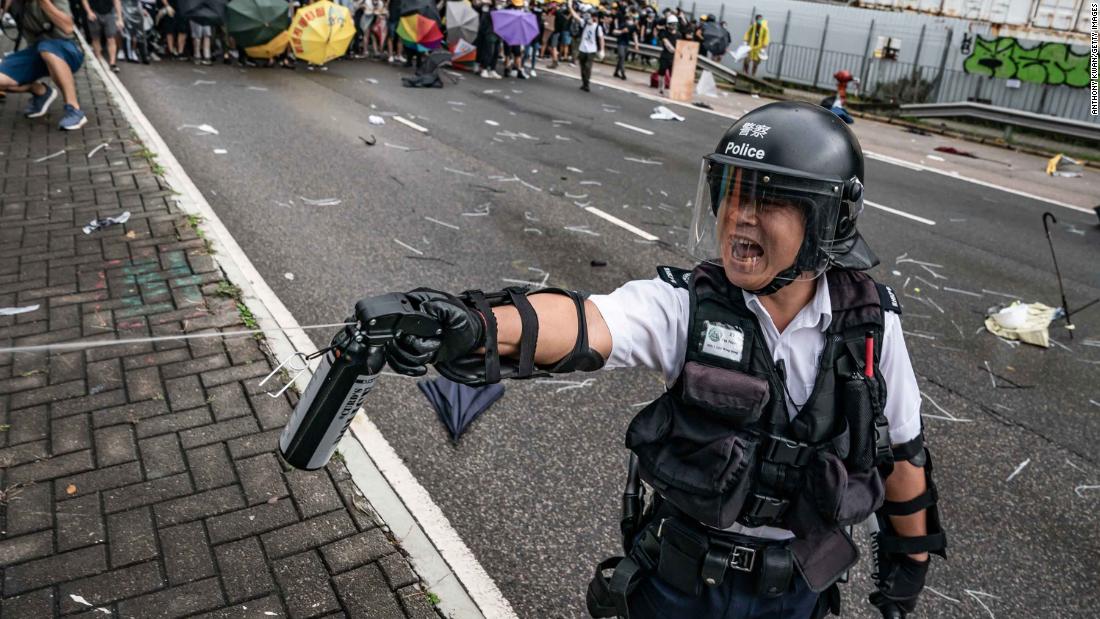
A police officer uses pepper spray during a clash with protesters on July 1.
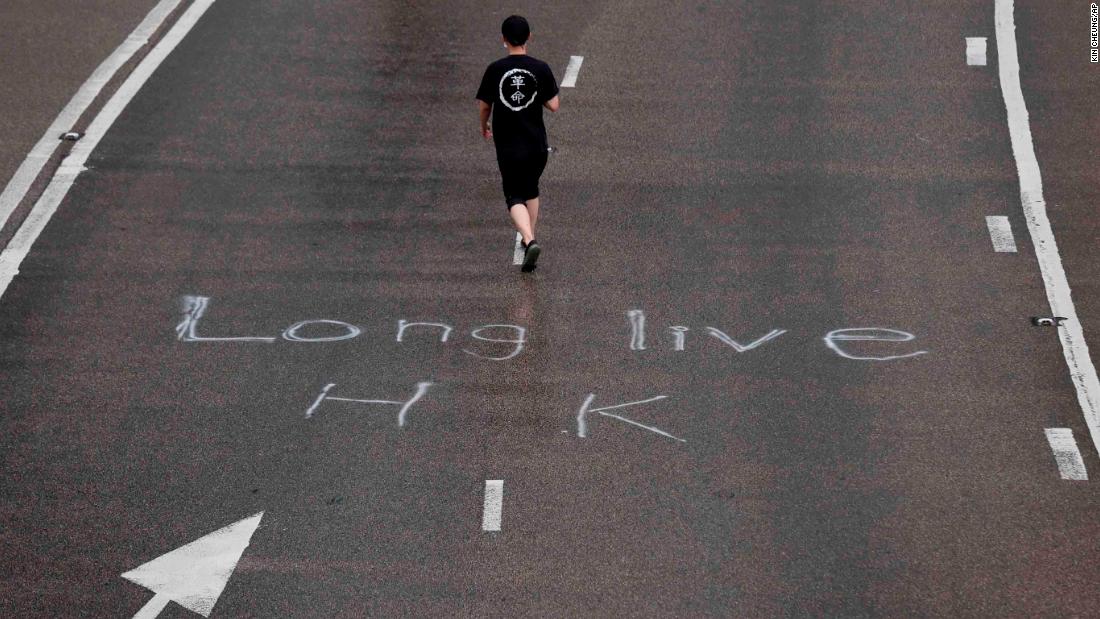
A protester wearing a T-shirt with the word "revolution" walks past an inscription on a road that reads "Long Live HK."

Police detain protesters near the government headquarters in Hong Kong on July 1.

An overhead view shows thousands of protesters marching through a Hong Kong street on Sunday, June 16.

Protesters run after police fired tear gas on Wednesday, June 12.

Protesters face off with police during the rally on June 12.
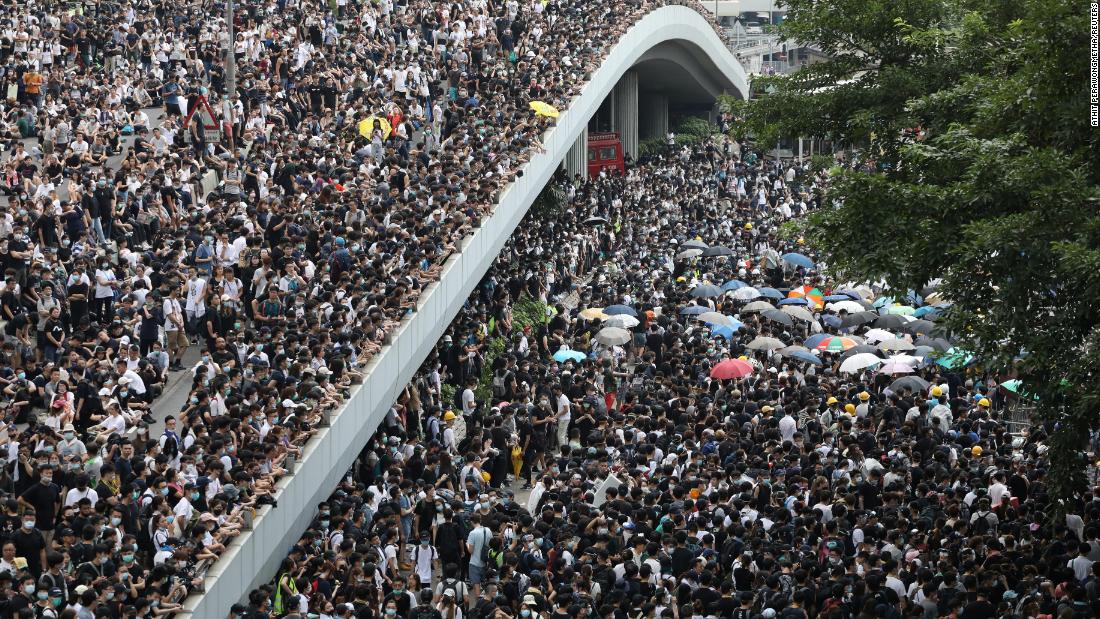
By the morning of June 12, tens of thousands of mainly young people had arrived in the area, blocking streets and bringing central Hong Kong to a standstill.

A demonstrator holds a sign during the June 12 rally.
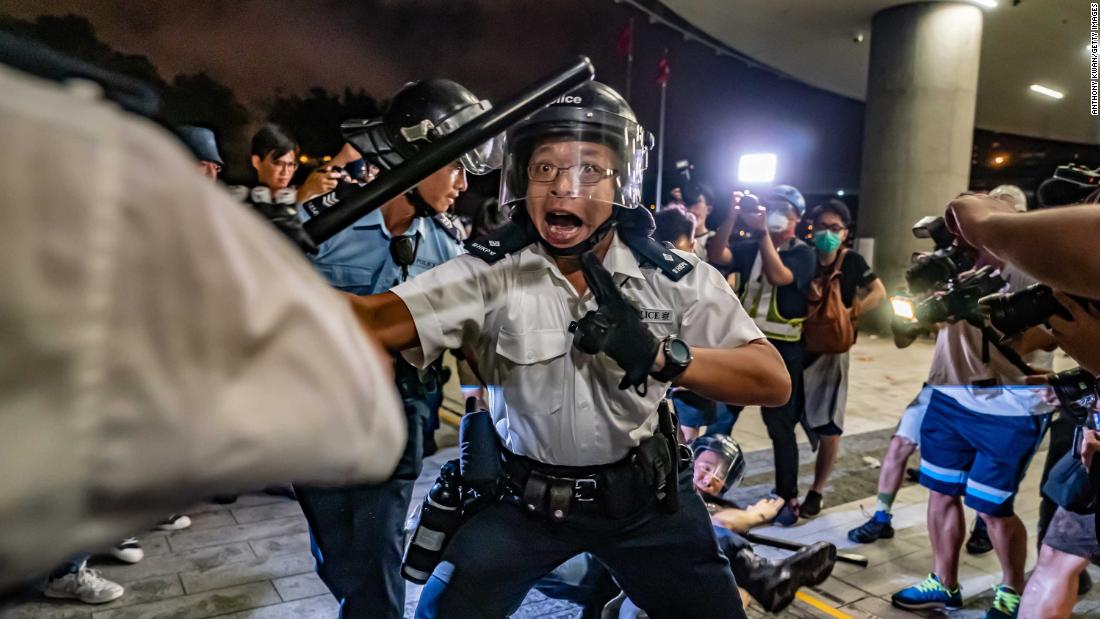
Police officers charge toward protesters during clashes on Monday, June 10. It was a continuation of protests that started the day before.

Protesters hold pictures of Hong Kong Chief Executive Carrie Lam on Sunday, June 9.
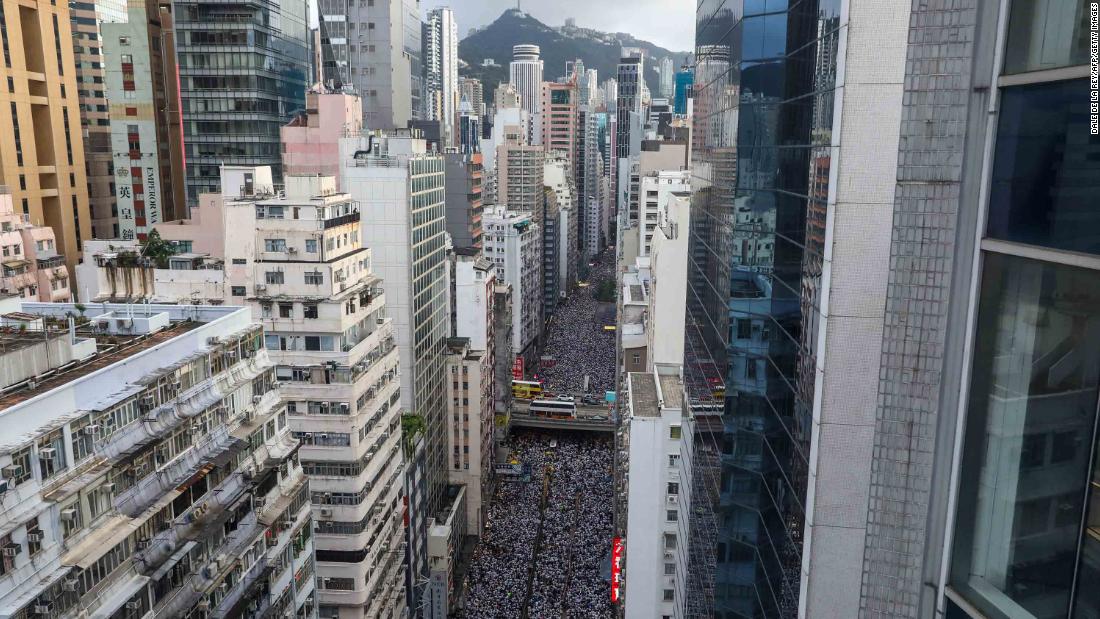
Protesters on June 9 waved placards and wore white -- the designated color of the rally. "Hong Kong, never give up!" some chanted.
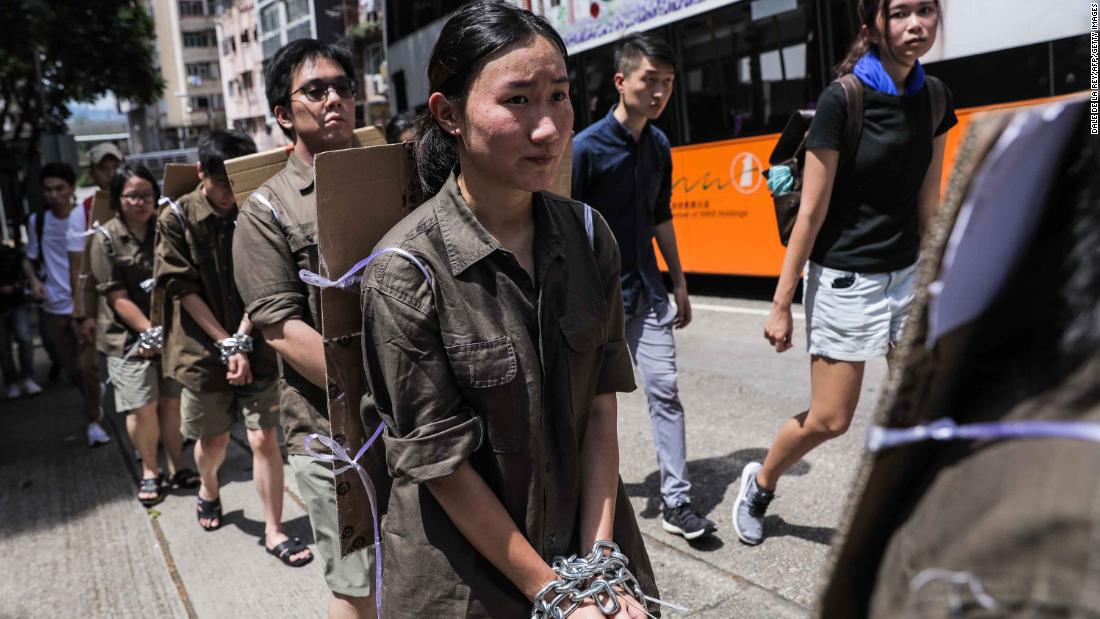
Students wear chains during a demonstration on Saturday, June 8.
However, US officials expressed skepticism that the rotation was routine, saying the Chinese troop movements, including the arrival of tactical vehicles and personnel carriers, puts Beijing's forces into a more immediate position to crack down.
"This is the time to start worrying," one US official told CNN at the time.
Any intervention from the PLA or the paramilitary PAP would likely be catastrophic for the city's economy, analysts say, and could spark a mass exodus.
But the longer the protests go on, the weaker Chinese President Xi Jinping looks, Davis said. And Xi will be weighing up the economic and political costs of intervening in Hong Kong while it is fighting a bitter trade war with the US and a slowing economy.
"The one thing that might be driving his thinking is that he will look at (the 1989 Tiananmen massacre) and see how quickly international engagement recovered afterward, in terms of the economy," Davis said.
While a Tiananmen-style crackdown is something most people in Hong Kong are eager to avoid, some of the more hardcore protesters have expressed otherwise.
As far back as August, some radical protesters said they welcomed a crackdown and were "ready for it" no matter the costs to the city and potentially the movement itself.
Unless both sides step back from the brink and some compromise is reached, the protests look likely to keep intensifying.
"I think that we are in the stage now, where things are going to slide towards some sort of military or People's Armed Police intervention. And that could be a devastating situation for the protesters," Davis said.
CNN's James Griffiths and Joshua Berlinger contributed reporting.

Post a Comment